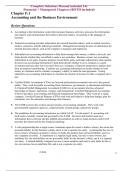Exam (elaborations)
Solutions for Horngren's Accounting, 14th edition by Tracie Miller-Nobles
- Course
- Institution
Complete Solutions Manual for Horngren's Accounting 14e 14th edition by Tracie Miller-Nobles, Brenda Mattison. Full Chapters Solutions are included THE FINANCIAL CHAPTERS Accounting and the Business Environment Recording Business Transactions The Adjusting Process Completing the Accounting C...
[Show more]



